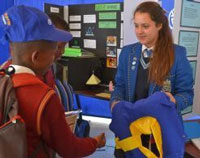
Mallabone's invention was one of many that were showcased at the 6th Annual Innovation Summit held between 27-29 August at the Industrial Development Corporation in Johannesburg. Unlike previous editions, which only brought together a limited number of high profile delegates, this year's event also invited hundreds of pupils from various schools in Gauteng for a youth day.
According to summit executive Jonathan Darker, the youth day was meant to teach pupils what innovation is really about. He said there is a misconception around the word as most people think innovation takes place in a controlled laboratory when it can actually occur anywhere. "Say 'innovation' to a child and they think seriously technical stuff when it is not the case. And they need to be aware that they are probably innovating themselves and they are not capitalising on their ideas."
Summit organisers did not limit the invitation to a specific kind of school, said Darker. The event was open to private, model C and rural schools. Those who were studying mathematics and science were given preference to attend. The summit organised three breakaway sessions for pupils that included talks on Lego robotics, and poster design for Nelson Mandela's 95th birthday.
Darker said schools do not teach children about the importance of intellectual capital and the social and financial value that comes with it. The summit, he added, attempted to make youngsters aware of such concepts. "There was an inventions garage at the exhibition where some inventors' prototypes were, so the children could see the actual invention. They could see it is not complicated and it actually makes life easier."
Mallabone's warming liner and Hand on Technologies' Lego Mindstorms robots were two such life-enhancing innovations that were showcased at the summit's Spark Lab exhibit.
Mallabone's warming liner comes as a two-layered attachment for life jackets. The first is made from synthetic rubber called neoprene, which provides warmth. It covers a heat pack which contains calcium oxide and is made from a very thin Drimac fabric. As soon as the wearer is immersed in water the calcium oxide will produce heat and warm the wearer's core - the abdomen and back.
"I tested it on myself to see if it really works," said Mallabone, a grade 11 pupil at St Teresa's High School in Johannesburg. "I jumped into water that is eight degrees Celsius and for an hour my body temperature remained at 36 degrees Celsius. So for an hour it will prevent body temperature from decreasing and prevent the onset of hypothermia."
The invention earned her a number of accolades which culminated in the American Intellectual Property Law Association Special Award at this year's Intel International Science and Engineering Fair held in Phoenix in the US. Mallabone started out by winning her school's internal expo. She then won gold at the Eskom Expo Regional competition in Johannesburg before winning another gold medal at the national Eskom Expo for Young Scientists Fair. "It was at nationals where I was chosen as one of nine participants to represent South Africa [in Phoenix]."
The invention is in the process of being patented, which Mallabone expects will be done by the end of the year.
Danie Heymans of Hands on Technologies exhibited the latest Lego Mindstorms EV3 range, which encourages children to build and program their own robots. The organisation is a licenced provider of Lego educational products in sub-Saharan Africa.
He said the Department of Basic Education has seen the value in the Lego technology as it is looking to add it into the curriculum. However, not all teachers are familiar with the product and have been reticent about incorporating it into their classrooms. Hands on Technologies has, therefore, taken the responsibility of training teachers on the use of Lego products. "We hold workshops and there is continued training even while the projects are going," said Heymans. "They can apply these tools to any subject that they teach."
Heymans said the technology would help children develop mathematical, manipulative and gross motor skills, which work large muscle groups. "Children are not developing these skills because they are sedentary; they are sitting still and playing games. Then what happens is the big muscle groups do not develop and even your academic progress is hindered."
With Lego Mindstorms, children have to learn to program a robot so it can carry out prompted commands. This kind of interactive learning, Heymans said, develops logical thinking and problem solving skills. "Children are not just watching the chalkboard. They are learning about cause and effect. They program the robot and check if it works. If it does not, then they must try again until they get it right."
Hands on Technologies currently runs outreach programmes with schools in Atteridgeville, a township in Pretoria, providing training in the use of Lego educational products. The programme has been running for five years, incorporating 25 schools in this period.
One of these projects involves building and using Lego's robots. Heymans said 40 pupils, who were split into eight groups of three, participated last year. Three of these groups were chosen to attend the World Robot Olympiad in Kuala Lumpur, Malaysia, where they finished in the bottom half out of 60 despite just four months of training.
This year, Hands on Technologies has added another two schools to their programme. The company has also converted a venue within an Atteridgeville school into a workstation where children are taught about robotics. Heymans said there are now 160 pupils from Atteridgeville attending training sessions once a week and participating in competitions as well.
MediaClubSouthAfrica.com is hosted by the International Marketing Council of South Africa (IMC), the custodian of Brand South Africa. The site is a free service for all media professionals - journalists, editors, writers, designers, picture editors and more - as well as for non-profit organisations and private individuals. Its specific focus is on South Africa and Africa.
Go to: http://www.mediaclubsouthafrica.com/